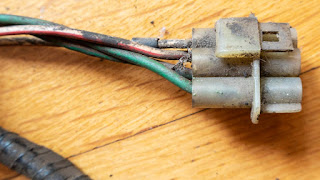As part of the pre MOT service I decided to change the spark plugs on both my road going TR7’s. To start with the plugs from ‘t Kreng. The Sprint powered car. These plugs have been in the engine since September 2014, covering 10.509 kilometres since.
They don’t look to bad, but I think the fact that cylinder #1 is slightly down on compression shows here. A check of the valve clearances might also be a good move!
While working on this car I did another check of the connecting tube (UKC2538) between inlet manifold and water pump cover. After the previous inspection I had cleaned and dried the area. And guess what, it was completely dry this time! So for the time being no action required!
Next it was time to change (and check) the DHC’s spark plugs. These were also fitted in 2014. But they have covered 20.220 kilometres since.
Again not much wrong , though I wonder while the plugs #2 and #3 are slightly wet with fuel. Rather weird as the engine hasn’t turned since September last year. Also clear that there is a light oil deposit on plug #3. Maybe a proper tune up (valve clearances and timing check ) will improve things here. But first I think the car needs to be used more!























